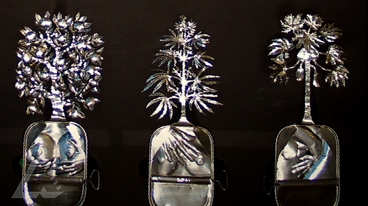Free for educational use
Fiona Hall
Year of production - 2006
Duration - 5min 0sec
Tags - art, artists, Betty Churcher, botanical, environment, preservation, sculpture, women, see all tags
On this Page

How to Download the Video Clip
To download a free copy of this Video Clip choose from the options below. These require the free Quicktime Player.
![]() Premium MP4 hidden6_pr.mp4 (36.9MB).
Premium MP4 hidden6_pr.mp4 (36.9MB).
![]() Broadband MP4 hidden6_bb.mp4 (17.4MB), suitable for iPods and computer downloads.
Broadband MP4 hidden6_bb.mp4 (17.4MB), suitable for iPods and computer downloads.
Fiona Hall is an episode of the series Hidden Treasures (15 × 5 mins) produced in 2006.
The National Gallery of Australia has more than 100,000 works in its collection—an extraordinary reservoir of creative vision and cultural history, from decorative arts to photography and sculpture.
Yet on a visit to the gallery, you’ll see only the tip of this iceberg. Carefully stored away are the things that can’t be placed on permanent display.
These unseen gems include works of exquisite fragility, from brilliant hand-painted fabrics to delicate works on paper. From Australia, the Americas, Africa, Asia, Europe, the Middle East and Oceania, there are masks and carvings, lithographs and linocuts, set designs and stage costumes, sketchpads and handprinted books, marionettes and maquettes, teapots and textiles, and much, much more.
Now in this series of micro-docs, former director of the gallery Betty Churcher presents an insider’s guide to some of these 'hidden treasures’.
In the entertaining, accessible style for which she is renowned, Betty Churcher takes us behind the scenes, sharing with us her passion and insights. From her unique vantage point, she makes intriguing connections between a range of different objects and artists, linking them to the stories that surround them.
These are fascinating tales—about the works themselves, the people who created them and the challenge of preserving them—and a tantalising look at some of the ideas and influences that have shaped modern art across the globe.
A Film Australia National Interest Program in association with Early Works. Produced with the assistance of the Australian Broadcasting Corporation.
Full program creditsStudents research, observe and reflect on their exploration to develop, discuss, express and support opinions about their own and others’ use of art elements, principles and/or conventions, skills, techniques, processes, media, materials, equipment and technologies. They compare, analyse, evaluate, and interrupt the content, meaning and qualities in artworks created in different social, cultural and historical contexts, offering informed responses and opinions and using appropriate arts language. They describe aspects and requirements of different forms, audiences and traditions, and identify ways that contemporary artworks, including their own, are influenced by cultural and historical contexts. They use appropriate arts language.
This material is an extract. Teachers and Students should consult the Victoria Curriculum and Assessment Authority website for more information.The many exotic species brought back from the South Pacific by 18th century European explorers fuelled the western imagination with ideas of paradise lost (in the old world) and regained (in the new).
Australian artist Fiona Hall has created a series of stunning botanical sculptures from sardine tins that she calls Paradisus terrestris. The lids of the tins roll back to reveal tiny sculptural forms.
The series alludes to the western world’s notion of the Garden of Eden and to the enormous variety of botanical species, and implies that paradise may be lost if environmental degradation is allowed to continue.
If, as the saying goes, money doesn’t grow on trees then, in Leaf Litter, Fiona Hall seems also to be telling us that there are some things that no amount of money can buy. In this work, she again reminds us of the fragile diversity of the natural world.
The series consists of 183 sheets each containing a life-size portrait of a leaf, meticulously painted in gouache over banknotes from the leaf’s country of origin. The leaves are transparent in places so that the person on the note underneath shows through. These multiple sheets are then held together with paper tape on the back, which when hung on a wall, allows the lower part to flex and move.
As well as displaying a whimsical imagination and a quirky sense of humour, in Fiona Hall’s work there is a palpable sense of her passion for the beauty and vulnerability of all living things. Only a deep love and commitment would provide the extreme patience required to create these exquisitely delicate works of art.
- Much of Fiona Hall’s work is about the environment. Identify and discuss the ideas and concepts evident in both Hall’s pieces Leaf Litter and Paradisus Terrestris, also drawing any similarities and differences between the two.
- One of Fiona Hall’s works is Tender, which features dozens of fragile birds’ nests made from shredded United States dollar bills, a commentary on the effects of modernisation, global trade and deforestation. Carry out research into art preservation techniques then discuss the methods required to preserve both Tender and Paradisus Terrestris.
- Make a series of environmental drawings of the same object. The first drawing of the object should be the most detailed. In each of the following drawings, reduce the amount of detail so that you progress from highly descriptive to a more obscured image.
- From your drawings create a series of whimsical, metal sculptures. Consider using recycled materials from objects such as aluminium cans, jewellery parts, wire, nuts, nails, screws or bolts. Include at least three different materials to create texture and interest within the piece.
Julie Ewington, Fiona Hall, Piper Press, Annandale, NSW, 2005


